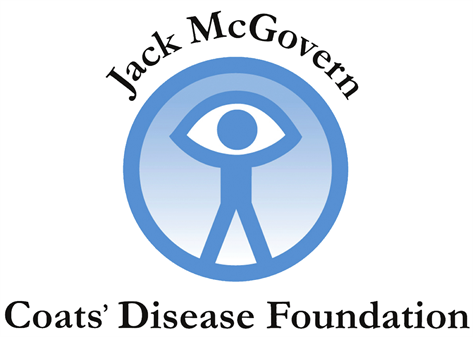
Jack McGovern Coats' Disease Foundation
Coats’ Disease is a very rare condition found in children and adults where there is abnormal development in the blood vessels behind the retina. The blood-rich retinal capillaries break open, leaking the serum portion of the blood into the back of the eye. The leakage causes the retina to swell, leading to partial or complete detachment of the retina. Coats’ Disease usually progresses gradually but can progress quickly, especially in children, and affects central vision. It is almost always unilateral (affecting only one eye). If caught early, some level of vision can typically be restored. If not treated until its later stages, complete loss of vision can occur. In the final stage, enucleation (removal of the affected eye) may be necessary.
Diagnosis: Two-thirds of Coats’ Disease patients are diagnosed as infants and children who may not exhibit symptoms or may develop misalignment of their eyes (strabismus) or a “white reflex” (leukocoria) from the affected eye’s pupil. Children are seen by Pediatricians who should refer the child to pediatric retina specialists. Diagnosis often requires an examination under anesthesia and a computed tomography (CT) scan of the eyes and brain. Age of diagnosis is from 1 month to 79 years. The median age is 5 years. The earlier age is associated with increased disease severity and accelerated progression. Because it is rare, it is often not diagnosed promptly by pediatricians in infants and young children who may not exhibit symptoms. Coats’ Disease afflicts males more frequently than females; an estimated 75% of patients are male.
Coats’ Disease is divided into four stages. While it’s possible that in its earliest stages, quality of life may not be severely affected, even in stage 2, half of eyes become legally blind despite treatment. Treatment involves laser to the retina and medicine injections into the eye to repair the retinal detachment and scarring. Currently, lost vision cannot be restored and there is no cure. In its advanced form, severe blindness is common. Patients must be monitored for life. Enucleation (removal) is sometimes required.
One scientific barrier is the difficulty in diagnosing the condition early enough to limit vision loss or prevent Coats' entirely. Because Coats’ disease manifests primarily in infants and young children, pediatricians are the first line of “defense” in the diagnostic odyssey. However, since Coats’ disease is so rare, few pediatricians recognize the symptoms, if indeed there are symptoms. Consequently, the diagnosis is often not made until there is permanent damage to the retina or retinal detachment. Lost vision cannot be restored.
In addition to lack of awareness about the disease among the pediatric community, little is understood about the pathophysiology of Coats’ disease. Increased awareness and early screening would be beneficial in shortening the diagnostic process.
The Jack McGovern Coats' Disease Foundation is a nonprofit, 501 (c)(3) charity that raises funds to support research, raise awareness, expand patient resources, and offer all patients hope and improvements as they wage a lifelong battle against Coats' disease and blindness. We have partnered with Know the Glow, a nonprofit 501(c)(3) that raises awareness of the Glow, the leukocoria, that appears in the eye in flash photography and is an indicator of more than 20 eye disorders. Know the Glow raises public awareness of the Glow and drive action to prevent childhood blindness. www.knowtheglow.org
Jack McGovern Coats' Disease Foundation
20 Park Road
Suite E
Burlingame, CA 94010

